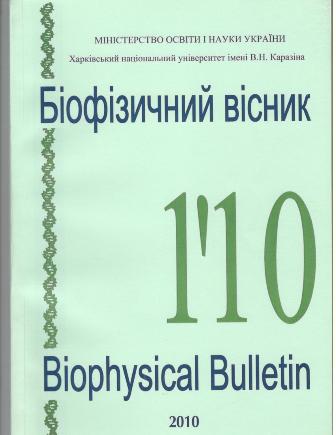Method of definition of degree of hydration in multicomponent heterogeneous disperse systems
Abstract
The method of calculation of the hydration in multicomponent heterogeneous disperse systems is presented. An example of the three-component disperse system representing the aqueous solution of bovine serum albumin (BSA), containing ultra dispersed nanodiamonds, the calculation of hydration on the experimental values of dielectric permittivity of the samples was carried out. The values of complex permittivity of the aqueous solutions of BSA (1 wt. %) in presence of nanodiamonds (0-3,15 wt. %) were measured by the method of microwave dielectrometry on the frequency of 9.2 GHz. Using the Debye equations the values of static permittivity of the samples used for the calculation of hydration were determined. The hydration increases at the adding of nanodiamonds to the protein solution up to the concentration of 1.8 wt. %. It can be explained by the strong ability of nanodiamonds to bind water. Hydration decreases at a further increase in the concentration of nanodiamonds that can be caused by the aggregation of particles.
Downloads
References
2. Аксенов С.И. Вода и её роль в регуляции биологических процессов. / С. Аксенов. – Москва-Ижевск: Институт компьютерных исследований, 2004. – 212 с.
3. Степин Л.Д. Исследование диэлектрических свойств дисперсных систем: автореф. дисс. на соиск. уч. степени канд. физ.-мат. наук: спец. 01.04.03 “Радиофизика” / Л.Д. Степин. – Харьков, 1965. – 12 с.
4. Мревлишвили Г.М. Низкотемпературная калориметрия биологических макромолекул. / Г.М. Мревлишвили. – Тбилиси : Мецниереба, 1984. – 189 с.
5. В.А. Кашпур, В.Я. Малеев, Т.Ю. Щеголева // Молекул. Биология. – 1976. – Т.10. – С. 568-575.
6. I.D. Kuntz, W. Kauzmann // Adv. Protein Chem. – 1974. – Vol. 28. – P. 259-345.
7. В.С. Бондарь, А.П. Пузырь // Доклады РАН. – 2000. – Т. 373. – С. 251.
8. А.П. Пузырь, В.С. Бондарь, П.И. Белобров, А.А. Букаемский // Доклады РАН. – 2000. – Т. 373. – C.408.
9. А.М. Ставер, Н.В. Губарева, А.И. Лямкин, Е.А. Петров // Физика горения и взрыва – 1984. – Т. 20, № 3. – С. 100.
10. Г.А. Чиганова // Коллоид. Журн. – 1994. – Т. 56, № 2. – С. 266.
11. Г.А. Чиганова, С.А. Чиганов // Неорганические материалы – 1999. – Т. 35, № 5. – С. 581.
12. A.P. Puzyr A.V. Baron, K.V. Purtov, [etc.] // Diamond and Related Materials. – 2007. – V. 16. – P. 2124-2128.
13. А.П. Пузырь, В.С. Бондарь, З.Ю. Селимханова и [др.] // Сибирское медицинское обозрение. – 2004. – Т.4. – С. 19-23.
14. А.П. Пузырь, Е.В. Бортников, Н.Н. Скобелев, и [др.] // Сибирское медицинское обозрение. – 2005. – Т. 1. – С. 20-24.
15. A.M. Schrand, H. Huang, C. Carlson, [et. al.] // J. Phys. Chem. B. – 2007. – Vol. 111, № 1. – P. 2–7.
16. Е.М. Мамотюк, В.А. Гусакова, Н.Е. Узленкова и [др.] // Український радіологічний журнал. – 2009. – № 17. – С. 65-71.
17. А.П. Пузырь, Д.А. Нешумаев // Биофизика – 2005. – Т. 50, № 1. – С. 101-106.
18. Чиганова Г.А. Разработка методов, способов и технологии направленного изменения свойств ультрадисперсных порошков, синтезированных детонационными методами: автореф. дисс. на соиск. уч. степени доктора техн. наук: спец. 05.16.06 “Порошковая металлургия и композиционные материалы” / Г.А. Чиганова. – Красноярск, 2006. – 41 с.
19. T.J. Buchanan, J.H. Haggis, J.B. Hasted, B.J. Robinson // Proc. Roy. Soc. – 1952. – № 213. – P. 379-391.
20. Grant E.H., Sheppard R.J., South G.P., Dielectric behavior of biological molecules in solution / Grant E.H., Sheppard R.J., South G.P. – Oxford : Clarendon Press, 1978. – 237 p.
21. J.A. Reynolds // Proceedings Physical Society. – 1957. – V. 370, 769 p.
22. О.Т. Николов, Т.А. Жилякова // Журнал физической химии. – 1991. – Т.65, №5. – C. 1417-1420.
23. A.L. Vereshchagin, V.F. Komarov, V.M. Mastikhin, et al. // Proceedings of the Vth All-Union Meeting on Detonation. – 1991. – V. 1, 99 p.
24. В.С. Бондарь, А.П. Пузырь // Физика твердого тела. – 2004. – Т. 46, №4. – С. 698-704.
Authors who publish with this journal agree to the following terms:
- Authors retain copyright and grant the journal right of first publication with the work simultaneously licensed under a Creative Commons Attribution License that allows others to share the work with an acknowledgement of the work's authorship and initial publication in this journal.
- Authors are able to enter into separate, additional contractual arrangements for the non-exclusive distribution of the journal's published version of the work (e.g., post it to an institutional repository or publish it in a book), with an acknowledgement of its initial publication in this journal.
- Authors are permitted and encouraged to post their work online (e.g., in institutional repositories or on their website) prior to and during the submission process, as it can lead to productive exchanges, as well as earlier and greater citation of published work (See The Effect of Open Access).





